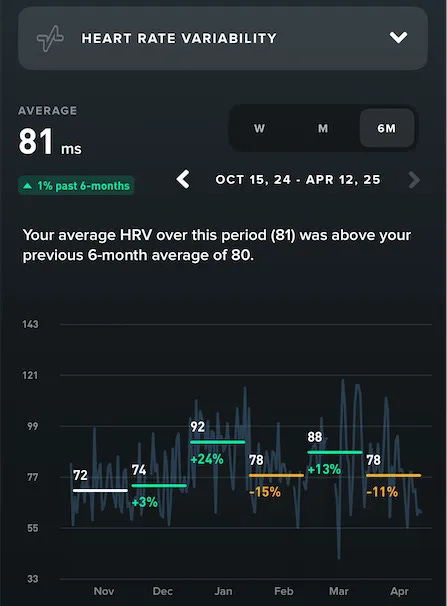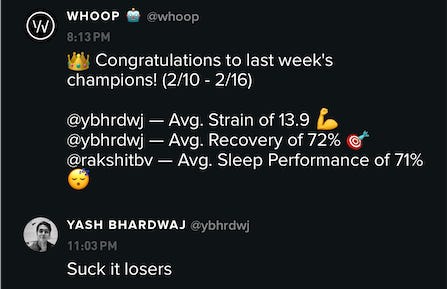Whoop, Is it worth it?
I’ve been using WHOOP for a year now, and in that time, a bunch of people have asked me what it actually does — and whether it’s worth it. So I thought, maybe I should write about it so I can just send this article instead.
The answer is a little nuanced but my answer is that getting a WHOOP is NOT worth it for MOST people for two reasons
Price: WHOOP runs on a $22/month subscription, so it keeps getting more expensive the longer you use it. There’s no one-time purchase option.
Behavior: If you’re not consistently active (running, gym, sports, etc.), you probably won’t get much out of WHOOP. Any basic fitness tracker will cover your needs.
That said, if cost isn’t an issue and you already live a fairly active lifestyle, WHOOP can be useful — if you use it well.
WHOOP tracks a ton of metrics, but I’ll only cover the most useful ones for someone moderately into fitness. And it all falls under three main buckets:
Strain
Sleep
Recovery
Let’s dive into each of them individually
Strain
Strain is pretty straightforward. WHOOP tracks how much physical stress you accumulate throughout the day and gives you a score from 1 to 21 based on cardiovascular or muscular strain. Of course, cardiovascular is easier to track using your heart rate. So the more strain you put your body through, the higher your score will be.
It’s excellent at tracking cardiovascular strain (heart rate-based), but not great with muscular strain. For example, a gym session barely moves the strain number for me, but a swim or run spikes it significantly.
This is how my Strain looks on a 6-month chart (I have been in rehab because of surgery so not the best numbers)
Sleep
Sleep tracking is honestly my favorite feature on WHOOP — and the main reason I’m okay paying for it. There are a lot of sleep metrics that you can track but a few that I look at are
Sleep performance: Hours of sleep needed vs. hours actually slept
Sleep consistency: How regular your bedtime and wake-up time are
Sleep efficiency: What % of your time in bed is spent asleep
Restorative sleep: Tracks how much time you get in REM and deep sleep (aka, the good stuff)
This is what my sleep performance looks like over a 6M timeline.
Recovery
WHOOP gives you a recovery score from 0-100% based on your strain and sleep. This recovery score means how ready I am to take on more strain on that day. I try not to obsess over this number daily — it can be mentally anchoring. But as a long-term trend, it’s incredibly useful. This score literally made me quit alcohol — every time I drank, my sleep and recovery scores tanked. Seeing the data made it impossible to justify the effects that intoxication has on us.
Two of the best recovery indicators — and the go-to question to ask someone wearing a WHOOP — are: “What’s your HRV & RHR?”.
Let me quickly explain these to you:
HRV (Heart Rate Variability): Measures the variation between heartbeats while you sleep. It’s highly individualized but generally, higher is better, and you want an upward trend over time.
RHR (Resting Heart Rate): Your heartbeats per minute while at rest. Lower is better — elite athletes can be in the 40s. Mine hovers between 58–60, so I’ve got a long way to go aerobically (Have attached a chart for you to know where your RHR should be at.).


Now that we know the metrics that it tracks for you, let me give you an insight into what I love about WHOOP itself.
Portable charger: You never need to take WHOOP off — it charges while you wear it. That alone fixed my biggest problem with the Apple Watch (I’d forget to put it back on).
Auto-tracking: WHOOP knows when you’re working out or napping. No need to log or start anything manually. It is accurate down to the minute when it comes to it. Same for sleep, it will track even if you take a nap during the workday 😉
Silent alarm: The band vibrates to wake me up. I set it to go off when my recovery is green — not at a specific time.
No screen: Don’t have to say no more, a huge plus. No notifications, no distractions.
Community: You can create groups within the app with all your friends, and then compare and compete with them. Another way to make life fun here is to have monthly bets on a certain metric. The winner gets the entire pool.
Features it has but I don’t use
WHOOP AI: It sounds cool — a GPT-based coach based on your data. But in my experience, the feedback is still too generic.
Journal: You can track habits daily and get correlations like “Alcohol reduces my recovery by X%.” I don’t use it much — mostly because I’m lazy.
Conclusion
I just renewed my WHOOP for year two. That should tell you something.
If you’re serious about your fitness and like tracking trends over time, WHOOP can be a game-changer. But if you’re not already active, or you know you’ll stop caring about optimization in a few months — it’ll just collect dust like that gym membership you stopped using in February.
If you’re considering WHOOP and still unsure, feel free to reply and let me know.









